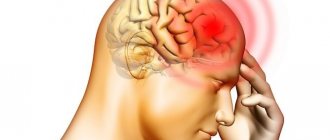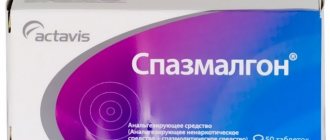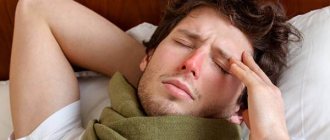Neuralgia is a lesion of the nerve trunk in any part of the body, which leads to pain.
The nerve can be damaged by injury, hypothermia, or degenerative changes in the spine (osteochondrosis).
A separate group of provoking factors are infectious diseases that cause neurological complications. These include postherpetic neuralgia, which can develop after a person has had the herpes virus.
In this article we will tell you how herpetic and postherpetic (after shingles) neuralgia manifests itself and how to treat it.
What is it, ICD-10 code
Any neuralgia is a nerve lesion . Its fiber contains sensitive receptors that communicate with the central nervous system by transmitting impulses. If a nerve is injured, it sends signals to the central nervous system and pain occurs.
Both herpetic and postherpetic neuralgia are the occurrence of pain due to human infection with the herpes virus (Herpes zoster).
The acute form of herpes infection is most often associated with a pain syndrome - herpetic neuralgia . As a rule, pain appears even before the appearance of a rash (characteristic of the course of the disease), precisely in those places where rashes will later appear.
During the acute period of the disease (up to 30 days from the onset of symptoms), the pain is usually intense. The pain syndrome spreads along the affected nerve column. With timely and adequate treatment, pain can be completely relieved.
If therapy is not carried out or does not help, then the disease passes first into the subacute phase (after 30 days), and then into postherpetic neuralgia (PHN). This diagnosis is made when pain symptoms do not go away for more than 4 months.
The main feature of PHN is the presence of persistent pain after the disappearance of other symptoms of the disease . The main difference between herpetic and postherpetic neuralgia is that with PHN, pain persists for a long time after the disappearance of all other manifestations of herpes (fever, rash, general malaise).
The disease has a separate number in the international classification of diseases (ICD-10). Neuralgia after herpes zoster received the code G53.0, where G indicates a disease of the nervous system, 53 indicates damage to the cranial nerves in various diseases, and the number 0 specifically indicates PHN.
Moreover, this code includes complications of the facial nerves (ganglionitis of the genu ganglion of the facial nerve, trigeminal neuralgia). To indicate damage to other parts of the body, the code G63.0 is used.
Symptoms
The pathology is manifested by constant pain, most often pressing and dull. It is often accompanied by a burning sensation. Periodic pain can take the form of tingling or shooting.
Allodynic syndrome is spontaneous in nature. A burning sensation appears in response to any touch, which is explained by an inadequate reaction of the spinal nerve roots to the stimulus. The patient is in a restless state. Severe pain is caused by wearing clothes.
Pain impulses spread along the irritated nerve endings, that is, they arise where the herpetic rash was widespread. Skin itching, numbness, and paresthesia may occur.
The long-term intense nature of herpetic neuralgia contributes to the appearance of mental disorders. Their symptoms include:
- asthenia;
- headache;
- emotional instability;
- frequent mood changes;
- decreased concentration;
- deterioration of intellectual abilities;
- absent-mindedness.
Headache is a symptom of postherpetic neuralgia.
The patient is emotionally unstable. In old age, pain is perceived more acutely, and signs of mental disorders are more pronounced.
Etiology of development
Postherpetic neuralgia develops as a complication of herpes zoster (or “shingles”).
The disease is one of the variants of the clinical manifestation of the chickenpox virus (Varicella zoster). It is he who provokes the development of chickenpox in childhood.
After a child has had it at an early age, the virus can remain in the body in a latent form for many years.
The main areas of colonization are the nerves of the thoracic and lumbar regions, as well as the trigeminal nerve (on the face) . Shingles appears in the form of a blistering rash and is accompanied by an increase in temperature.
The disease goes through three stages of development:
- Initial (lasts 2-3 days, preceding the rash. May be accompanied by acute skin pain and itching).
- Rash stage (lasts about two weeks: from the appearance of blisters to their breaking and drying).
- Pain stage (develops after the rash has healed; it is this that can subsequently develop into postherpetic neuralgia).
According to statistics, about 20% of patients suffer from complications of the disease in the form of postherpetic neuralgia.
The virus affects the peripheral nervous system and leads to chronic pain that does not go away for months. The diagnosis is made when pain persists for 4 months after the onset of the disease . At the same time, a number of experts claim that the disease can be called chronic if after 2-3 weeks a new rash does not appear and the pain does not subside.
Risk factors
Due to disagreements among doctors regarding the timing of the development of the chronic phase of the disease, statistical data on the prevalence of the disease have not been fully collected. Nevertheless, certain risk factors have been identified.
These include:
- Elderly age . According to statistics, the probability of developing PHN is 40% in patients over 50 years of age and 75% in people over 75 years of age.
- Female . Women account for 60% of complications of herpes infection.
- Severe course of the acute phase of the disease (massive skin rashes, severe pain).
Symptoms and nature of pain after shingles
The peculiarity of postherpetic manifestations is the expansion of the affected area . Places where there were no rashes may begin to hurt.
The virus can infect different parts of the peripheral nervous system (the nerve itself, its root, etc.). Hence the different types of pain that patients complain about.
There are 3 groups:
- Constant pain (it can be described as dull, burning, pressing).
- Sudden (it is described as shooting, stabbing, sharp).
- Pain from non-painful stimuli (can occur from light touch, contact with clothing, etc.).
What do patients complain about?
For PHN there is no single characteristic of pain syndrome . For some it may be permanent, while for others it may appear periodically. Its intensity also varies greatly: from mild to unbearable.
Some patients complain of severe skin itching , which persists after the disease passes from the acute to the chronic stage. In some cases, complete loss of tactile and pain sensitivity is possible.
Patients with PHN often report chronic fatigue, lack of appetite, weight loss, and depression. Statistics show that more than 50% of patients have sleep disorders. Such manifestations seriously complicate a person’s life, reducing its quality up to the point of social disadaptation.
For example, increased sensitivity to even light contact with the body makes everyday activities difficult: patients cannot wash dishes, take a bath, get a haircut, etc.).
Find out more about the types and forms of neuralgia:
- inflammation of the sciatic and external cutaneous nerve of the thigh;
- glossopharyngeal and pterygopalatine node;
- damage to the pelvic, occipital and brachial nerves.
How it manifests itself
The symptoms of postherpetic neuralgia are constant and practically do not change. The main one is pain, which can have very different degrees of intensity. Pain can be of several types:
- Constant, at the same time it is dull, pressing, with a clear burning sensation.
- Periodic, shooting character.
- Sudden, which appears upon contact with an irritant.
There is increased sensitivity of the skin in the affected area. In addition to pain, the patient will complain of numbness or tingling, as well as severe itching. Sometimes muscle weakness appears, as well as a headache, which appears if the rash appears on the face.
If only one nerve is damaged, paralysis can occur, but this is extremely rare.
All this leads to the fact that the patient is constantly depressed, he cannot perform his direct duties at work, his sleep is disturbed, constant fatigue and insomnia appear, and social activity decreases.
How is the problem diagnosed?
Diagnosis of PHN is complicated by the large time gap between the development of the acute phase of herpes zoster with skin rashes and the appearance of neurological complications, which can make themselves felt 6 months after the onset of shingles.
The localization of pain determines which doctor the patient will see. As a rule, with complaints of discomfort in the neck and back, the patient consults a neurologist.
The main task of the doctor is to differentiate PHN from other diseases of a non-infectious nature:
- Visit to the doctor. If the pain is localized in any part of the spine, then the diagnosis will be carried out by a neurologist. If the facial nerves are damaged, the patient can contact both an otolaryngologist and a dentist.
- The doctor takes an anamnesis (finds out the patient’s medical history). Here it is important to find out the duration of the manifestation of pain symptoms, as well as the fact of having chickenpox or shingles in the distant and not so past.
- The doctor conducts diagnostics in order to differentiate PHN from other diseases. For this purpose, instrumental research methods (MRI, CT) are used. They help confirm or refute other diagnoses with similar symptoms (hernia, osteochondrosis, spondylitis, etc.)
- Laboratory differential diagnosis includes blood tests that will help exclude rheumatoid arthritis, diabetes mellitus and a number of other diseases that cause symptoms similar to PHN (polyneuropathy in diabetes, common pain in rheumatism, etc.)
- To confirm the diagnosis of postherpetic neuralgia, the doctor evaluates the totality of symptoms in the pain area and conducts laboratory tests to determine antibodies to Herpes zoster (in order to find out whether the patient has ever had this virus). In the absence of rashes, postherpetic neuralgia can be confirmed by immunohistochemical analysis and taking a biopsy from the area affected by pain.
Symptoms of herpetic neuralgia
Disturbances occur in a limited area of the body, usually on one side, where the nerve trunk affected by the virus passes. The disease is characterized by a combination of three signs:
- Pain. It can be burning, stabbing, aching. Typically lasts 3 months or longer after recovery from shingles.
- Allodynia. This compound word denotes a condition when pain arises from influences that do not lead to it in healthy people. With herpetic neuralgia, pain can occur from light touches to the skin or clothing.
- Itching and numbness. Less common symptoms.
The disease does not pose a great danger, but due to constant pain, over time, a person begins to experience increased fatigue, depression, his appetite decreases, and he cannot sleep properly.
In order to prevent complications, you need to consult a doctor at the first signs of herpes. The earlier a sick person began taking antiviral drugs, the lower the risk that he will be bothered by pain in the future.
Most often, the doctor makes a diagnosis after examining the patient. Additional studies and analyzes are not needed.
How to treat pain after herpes?
Treatment methods for postherpetic neuralgia (after shingles) in young and elderly people will depend on the stage of the disease and the severity of complications.
Antiviral therapy
Antiviral therapy is used to treat the acute phase of herpes. The use of Acyclovir and its analogues is effective .
The essence of the drug’s action is its ability to integrate into the DNA chain of viral particles in order to interrupt the pathological process and stop the reproduction of the virus.
Drug treatment
To treat complications in the form of PHN, medications are prescribed: tricyclic antidepressants (amitriptyline, nortriptyline) and antiepileptic drugs, in particular Finlepsin (Carbamazepine).
Pain relieving patches
The use of local (local) painkillers is quite effective.
For example, they actively use patches that are glued to the affected area ; they contain an anesthetic, in particular Lidocaine.
Another effective patch is one with a high content of capsaicin. The active substance blocks pain receptors in the skin. Using this method can relieve pain for up to 3 months .
Ointments
Another option for local anesthesia is the use of ointments. In particular, capsaicin is also available in this form. Ointments containing non-steroidal anti-inflammatory drugs (diclofenac) are also used.
Epidural blocks
Epidural blockades are used to relieve pain. This is an effective method of pain relief for various pathologies of the spine.
Anesthetics and steroid hormones are injected into the epidural space, which leads to loss of sensitivity in the area of influence.
Traditional recipes for home use
To relieve the symptoms of the disease, you can use traditional recipes:
Rubbing with garlic tincture . 1 tablespoon of garlic is infused with 500 ml of vodka for several days. The resulting tincture is rubbed on the sore spot several times a day.- Radish compresses . You need to cut a hole and fill it with honey. Leave in a warm place for a couple of days. The resulting liquid is applied to the affected area.
- Baths with pine infusion . A decoction is prepared from young pine cones and shoots. Baths are recommended to be used 2-3 times a week in the evenings before bed.
Radiofrequency nerve destruction
Radical methods are also used to combat the consequences of complications. Destruction is a modern technology for treating various types of neuralgia . Its essence is to destroy the nerve by heating it with electric current.
The operation is minimally invasive (gentle) and does not require deep intervention in the body tissues. The current is transmitted through a needle, which is inserted directly into the nerve.
Treatment of postherpetic neuralgia
The disease is treated by a neurologist or neuropathologist. You need to contact a specialist at the first signs of postherpetic neuralgia for diagnosis and prescribing a therapeutic course. The result of treatment for neuralgia is considered achieved only if, with the help of the prescribed course, it was possible to restore the nerve sheath damaged by the virus.
Diagnostics
To make a correct diagnosis, the attending physician must study the medical history, examine the patient and prescribe him a herpes test. To carry out differential diagnosis, the patient may be prescribed such types of examination as ultrasound, MRI, etc.
To carry out differential diagnosis, the patient may be prescribed a type of examination such as ultrasound.
Drug treatment
There are several dosage forms of drugs that have a local effect on the affected area: ointment, cream, patch. The drug Nicoflex, an ointment with red pepper extract, shows high effectiveness. A lidocaine patch helps protect the affected area of skin from rubbing by clothing and other external irritants. Lidocaine has an analgesic effect. Medicines can be given to the body in the form of injections or tablets. It is not always possible to relieve pain in a short time.
Even with highly effective treatment, neuralgia can last for years.
Calcium channel blockers (Gabapentin, Pregabalin) are used to relieve pain. The treatment regimen may involve a gradual increase in dosage. If blockers show low effectiveness, the patient is prescribed anticonvulsants, for example, Finlepsin. Elderly patients may be prescribed tricyclic antidepressants (amitriptyline). These same drugs are also prescribed to people with severe immunodeficiency.
If the patient has persistent pain, opioid analgesics, for example Neuromidin, are used. The drug eliminates pain and burning, reduces the conductivity of nerve endings. The course of treatment lasts 2 months. The medicine is administered to the patient 3 times a day. If this drug turns out to be ineffective, the intercostal nerves and sympathetic nodes are blocked with potent drugs. During pregnancy, pain relief is carried out with caution, since not every drug is safe for the woman and child.
If the patient has persistent pain, opioid analgesics, for example Neuromidin, are used.
Folk remedies
Alternative medicine recipes help improve a person’s condition and reduce pain at home. Relief will come from:
- Fir oil. It is necessary to rub the substance into the area where pain is localized. The patient can have a light massage 3 times a week. The course of treatment lasts a month.
- Garlic-vodka compress. Garlic oil is mixed with vodka in a ratio of 1:100. Moisten a clean napkin with the resulting mixture, which is then applied to the affected area for 40-60 minutes. The procedure is repeated 2 times a week until the symptoms of neuralgia disappear.
- Black radish juice. This medicine has always received only positive reviews. It is necessary to cut a medium-sized depression in the radish, which then needs to be filled with honey. The radish is left for two days in a warm place in a deep bowl. During this time, the juice should stand out. Mixed with honey, it becomes a healing agent for external use. Compresses with radish juice can be made twice a day. To achieve the desired effect, the procedure must be repeated daily for 7-10 days.
- Baths with pine cones. The procedure is carried out for a month 2-3 times a week before bedtime. 500-600 g of cones must be boiled for 15-20 minutes in 2 liters of water. The resulting broth is poured into the bath and several liters of water are added to it. The procedure lasts 20-30 minutes.
- Infusion of sleep-herb. To prepare the medicine you need to pour 1 tbsp. l. plants 200 g boiling water. The medicine is infused throughout the day. You should take 50 g of liquid before bed. The course of treatment lasts at least 10 days. Sleep herb helps cope with neuroses, relieves depression, causeless anxiety and insomnia.
What else to read: How to remove a scar from herpes?
Treatment in a sanatorium
Boarding houses specializing in the treatment of neuralgia will help you get rid of the disease. Once in a health facility, the patient has the opportunity to eat properly and rest according to the schedule. A mandatory condition for staying in a sanatorium may be the cessation of bad habits, which also helps to improve well-being in case of postherpetic neuralgia.
Mineral baths and healing mud have a positive effect on the patient’s health. Therapeutic massage for neuralgia relieves inflamed nerve roots and relaxes muscles. Physiotherapy procedures, such as electrophoresis, are prescribed when the patient cannot receive medications in the form of injections or tablets. Electrophoresis allows drugs or vitamins to be transferred directly to affected tissues. Patients are often prescribed electrophoresis procedures with novocaine.
Boarding houses specializing in the treatment of neuralgia will help you get rid of the disease.
Prevention
Neuralgia can be prevented by not allowing the herpes virus to become active. To do this, the patient must strengthen his immune system. You need to include fresh fruits and vegetables in your daily diet. Twice a year you need to take vitamin complexes. It is worth giving up smoking and reducing the consumption of alcoholic beverages to a minimum. Hardening will help strengthen the immune system. It is important to avoid hypothermia, which activates the herpes virus.
The patient is recommended to exercise. Physical activity stimulates nerve cells and helps maintain them. Exercising helps prevent muscle weakness. It is impossible to completely get rid of the herpes virus, which has become an indirect cause of neuralgia. However, the body is able to develop immunity to the virus.
Prevention and prognosis
The prognosis depends on the severity of the lesion and the intensity of the symptoms. With early consultation with a doctor and comprehensive treatment of neuralgia, the disease can be completely defeated . In especially severe cases, the pain syndrome cannot be completely relieved and persists for many years or until the end of the patient’s life.
Prevention of the development of PHN comes down to its prevention during the acute phase of herpes zoster.
Previously, it was believed that timely antiviral treatment of herpes could completely block the development of post-herpetic complications. Recent clinical studies refute this point of view.
In any case, the connection between the intensity of pain in the acute period and the development of PHN has been proven . Timely pain treatment can have a positive effect on the further course and formation of PHN.
Comprehensive prevention includes:
- Strengthening the immune system.
- A balanced diet rich in vitamins.
- Routine vaccination against chickenpox.
Postherpetic neuralgia is a serious complication of herpes zoster . In terms of prevalence among neuropathic pain, it ranks fourth after back pain, cervical/lumbar spine pain and diabetic polyneuropathy.
In case of infection with the virus, comprehensive and timely treatment is required. A developed postherpetic complication can masquerade as other pathologies for a long time and seriously reduce the patient’s quality of life.
How to get rid
Treatment of postherpetic neuralgia with timely consultation with a doctor will be successful. It is carried out both in the hospital and at home. Most often, the list of drugs prescribed by a doctor looks like this:
- Antidepressants.
- Painkillers.
- Drugs to block certain nerves.
- Local medicines.
- Physiotherapy.
- Acupuncture.
Depending on the severity of the symptoms of postherpetic neuralgia, the duration of treatment will depend. Moreover, the main task of the doctor is to reduce or completely eliminate the possibility of pain.
Sometimes doctors may recommend that patients use traditional medicine methods. This can be grinding using black radish or garlic juice, which is mixed with alcohol. You can also use infusions of various herbs or propolis ointment, or using other beekeeping products.
Postherpetic neuralgia can last from several days to a week.










